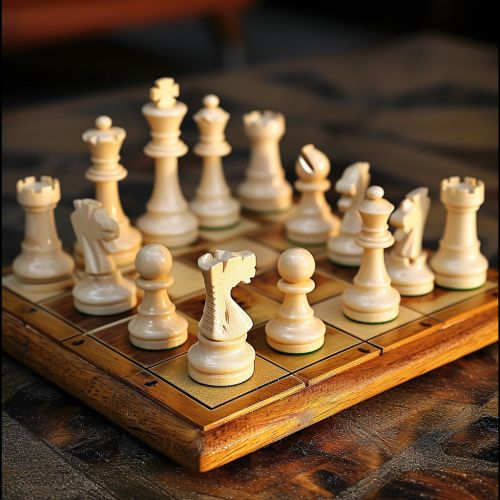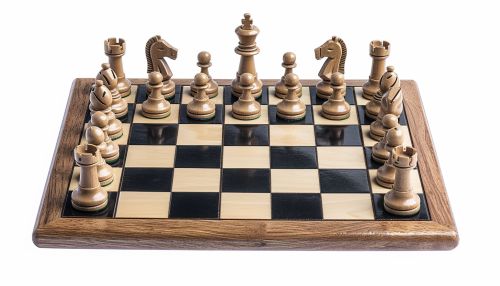Chess
History
Chess is a two-player strategy board game played on a checkered gameboard with 64 squares arranged in an 8×8 grid. The game is played by millions of people worldwide. Chess is believed to have originated in India, during the Gupta Empire (around the 6th century AD), where its early form in the 6th century was known as chaturanga. This translates as 'four divisions of the military' – infantry, cavalry, elephants, and chariotry, represented by pawn, knight, bishop, and rook respectively.


From India, the game spread to Persia. When the Arabs conquered Persia, chess was taken up by the Muslim world and subsequently, through the Moorish conquest of Spain, spread to Southern Europe. In Europe, the moves of the pieces changed in the 15th century to resemble the modern game, with further key rules about stalemate and castling being finalized in the 19th century.
Gameplay
At the beginning of the game, the chessboard is laid out so that each player has the white (or light) color square in the bottom right-hand side. The chess pieces are then arranged the same way each time. The second row (or rank) is filled with pawns. The rooks are placed on the corners, followed by the knights next to them, then the bishops, and finally the queen, who always goes on her color (white queen on white, black queen on black), and the king on the remaining square.
The player controlling the white pieces places his pieces on ranks 1 and 2, and the player playing the black pieces places his pieces on ranks 7 and 8. The white player always moves first. After the first move, players alternate turns. Pieces are moved to either an unoccupied square or one occupied by an opponent's piece, which is captured and removed from play. With the sole exception of en passant, all pieces capture opponent's pieces by moving to the square that the opponent's piece occupies.
Rules
Each type of chess piece has its own method of movement. A piece moves to a vacant square except when capturing an opponent's piece. With the exception of the knight, pieces cannot jump over each other. The king moves one square in any direction. The rook can move any number of squares along a rank or file, but cannot leap over other pieces. The bishop can move any number of squares diagonally, but cannot leap over other pieces. The queen combines the power of the rook and bishop and can move any number of squares along a rank, file, or diagonal, but cannot leap over other pieces.
The knight moves to any of the squares immediately adjacent to it and then makes one further step at a right angle. The knight's movement can also be viewed as an 'L'-shape: two squares in one direction and then one square perpendicular to that. The knight is the only piece that can 'jump over' other pieces.
The pawn has the most complex rules of movement: A pawn can move forward one square, if that square is unoccupied. If it has not yet moved, the pawn has the option of moving two squares forward, provided both squares in front of the pawn are unoccupied. A pawn cannot move backward. Pawns are the only pieces that capture differently from how they move. They can capture an enemy piece on either of the two spaces adjacent to the space in front of them (i.e., the two squares diagonally in front of them) but cannot move to these spaces if they are vacant.
Strategy and Tactics
Chess strategy is concerned with evaluation of chess positions and with setting up goals and long-term plans for future play. During the evaluation, players must take into account numerous factors such as the value of the pieces on the board, control of the center and centralization, the pawn structure, king safety, and the control of key squares or groups of squares (for example, diagonals, open files, and dark or light squares).
Chess tactics are usually consecutive series of moves, often initiated by a sacrifice, which leaves the opponent few options and results in tangible gain. At a most basic level, tactics involve calculations that can play out in several moves. Some tactical patterns can be very complex and stretch over many moves.
Phases of the Game
Chess games consist of three stages. The first is the opening, which is the group of initial moves of the game, or the opening moves by each player. The opening phase of the game is when players develop their pieces to useful squares where they will have an optimal impact on the game. During the opening, players also strive to control the center of the board and to keep their king safe.
The middlegame is the part of the game which starts after the opening. There is no clear line between the opening and the middlegame, but typically the middlegame will start when most pieces have been developed. The middlegame is the phase in which most combinations occur. Combinations are a series of tactical moves executed to achieve some gain. Middlegame combinations are often connected with the attack against the opponent's king.
The endgame (or end game or ending) is the stage of the game when there are few pieces left on the board. There are three main strategic differences between earlier stages of the game and endgame: pawns become more important; the king, which must be protected in the middlegame owing to the threat of checkmate, becomes a strong piece in the endgame and it can be brought to the center of the board; and zugzwang, a disadvantage because the player has to make a move, is often a factor in endgames but not usually in other stages of the game.
Chess Equipment
The pieces are set out as shown in the diagram and photo, with each queen on a square of its own color, the white queen on a light square and the black queen on a dark. The pieces are divided, by convention, into white and black sets. The players are referred to as "White" and "Black", and each begins the game with 16 pieces of the specified color. These consist of one king, one queen, two rooks, two bishops, two knights, and eight pawns.
The standard chessboard is made up of eight rows and eight columns for a total of 64 squares of alternating colors. Each square of the chessboard is identified with a unique pair of a letter and a number. The vertical files are labeled a through h from left to right from the white player's point of view, and the horizontal ranks are labeled 1 to 8 from bottom to top.
Variants and Related Games
There are many variants of chess that utilize different rules, pieces, or boards. One of the oldest of these is shatranj, which is an ancestor of chess as we know it today. Other variants include xiangqi, shogi, janggi, and makruk, each of which is a representative of a different regional chess tradition. Some variants have different pieces (such as the Amazon, which combines the powers of the queen and knight), different board layouts and sizes, or unusual rules.
Chess-related games, at times called chess variants, are games of all types that are similar to chess. One of the most popular today is chess960 (or Fischer Random Chess), where the initial position of the pieces is determined randomly.
